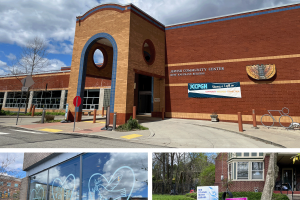
When Yamina Saheb started work with the Intergovernmental Panel on Climate Change in 2019, she was stunned at the treatment meted out to researchers from the “global south.” Diversity, equity, and inclusion seemed laughably alien concepts at the organization, which is tasked under the United Nations Environment Programme with charting a safe path for humanity through the climate crisis. Saheb, an energy economist specializing in the built environment, had a foot in the south as a dual Algerian-French citizen, and so she had long been aware of issues of inequity in the global research community. But the IPCC, which is structured to “bring together experts from all around the world” in working groups, exceeded her expectations of institutional prejudice.
The IPCC, in her view, was a place of glass ceilings for researchers from poorer countries. There were arbitrary bureaucratic obstacles to getting research read and accepted, technological deficits, onerous paywalls, and systematized bias in scientific journals. Climate sustainability thinkers from sub-Saharan Africa, Latin America, and southeast Asia were treated as second-class participants. “It looked like a continuation of colonialism,” Saheb told me.
Saheb’s colleagues, fellow IPCC authors, often remarked on this state of affairs — and yet it seemed to be accepted at the IPCC as the norm.
“It looked like a continuation of colonialism.”
“The constraints faced by global south researchers are appalling,” Julia Steinberger, professor of ecological economics at Lausanne University in Switzerland, told me. Steinberger described how researchers, at the height of the Covid-19 pandemic, broke lockdown rules to travel to their offices in order to join meetings on Zoom, because their home internet and computing systems weren’t up to the task. Digital infrastructure even at institutional offices routinely failed. Saheb told me about a colleague from Tanzania, an ecological engineer at Ardhi University in Dar-es-Salaam, who “lagged behind the rest of us” simply due to computing issues.
According to Steinberger and Saheb, the IPCC made little to no investment for researchers to access advanced computers and Wi-Fi systems so they could join online meetings. “The result,” Steinberger said, “was that many simply were cut off from the process altogether. And this despite research institutions and the IPCC saving tons of money on travel and hotel expenses” during the pandemic. The IPCC’s media office did not respond to a request for comment on technological investments for researchers.
Even more distressing to Saheb was the continued inequality built into the IPCC’s vision of our collective future. According to the “integrated assessment models” that the IPCC uses to project the state of the international economy under a regime of warming in the 21st century, the global south stays poor and the north stays rich. The north is asked to make no sacrifices, no changes to lifestyle, and the south is supposed to accept massive land-use conversion for mitigation of carbon emissions — emissions for which the north is primarily responsible.
“It’s business as usual,” Saheb told me. “Just unbelievable. We are in 2022. And yet what we see at the IPCC is the continued domination of the north over the south.”
The domination starts with access to prime academic databases, such as Scopus and Web of Science, required for researchers to make proper citations in their climate studies in order to be granted consideration at the IPCC. Without citations to give the imprimatur of authority in a paper, the chance of getting published in a peer-reviewed journal plummets — and the IPCC only accepts peer-reviewed work.
For global south researchers, the cost of accessing Scopus and Web of Science databases — which together house 44,000 journals, 18 million conference papers, and tens of thousands of books — often stretches the meager budgets of their institutions. While institutional fees for Scopus, managed by the for-profit science publishing giant Elsevier, are proprietary and held in secret, a Texas A&M University Libraries report estimated them at $140,000 a year. Web of Science at A&M cost more than $212,000 a year. Other studies have found that bundled access to Elsevier journals can reach $1.2 million annually at top-tier research universities.
“The simple fact is that if you don’t have access to these databases,” said Saheb, “you are out.” For many of her colleagues, the paywalls were impossible to scale.
There is a self-perpetuating loop in which research from the global south rarely finds acceptance at journals such as Nature and Science, which are considered the gold standard publications for climate-related work. McGill University research scientist and writer Madhukar Pai reported in a 2020 Forbes Magazine piece that these “prestige journals” are “elite, exclusive and exclusionary,” with evidence showing that research from scientists in low- to middle-income countries is subject to consistent bias.
Pai interviewed more than 20 global south scientists in the wake of news that Nature was charging an exorbitant “article processing charge” of roughly $11,000 from researchers seeking open-access publication in its journal. (Yes, you read that right: Scientists working with Nature — and this applies to many other similarly prestigious journals — must pay to have their work published in a way that the public, and other scientists, can see it.) That sum, Pai found, was the equivalent of the net annual earnings of scientists in many African institutions, the salary of an assistant professor in a medical school in India, and more than the salary of a microbiologist in Bangladesh.
Photo: Christophe Gateau/picture alliance via Getty Images
“The barrier to entry for climate mitigation scenario modeling is extremely high,” said Jason Hickel, an economic anthropologist and senior fellow at the London School of Economics’ International Inequalities Institute, who has analyzed the assumptions of integrated assessment models. “The IPCC only includes scenarios that are modeled on IAMs, and producing IAMs requires large teams of researchers and massive resources,” Hickel told me in an email. “As a result, there are only a handful of institutions in the world that produce the IAMs and create most of the mitigation scenarios, and all of them are in rich countries.”
Control of IAMs modeling rests with eight institutions: the Potsdam Institute for Climate Impact Research in Germany; the International Institute for Applied Systems Analysis in Austria; the University of Maryland in the U.S.; the Netherlands Environmental Assessment Agency; the European Institute on Economics and the Environment in Italy; the Environmental Agency of Japan; the Paul Scherrer Institute in Switzerland; and the European Union’s Joint Research Centre. (The IPCC does not produce its own scenarios; it simply reviews the existing published literature.)
It should come as no surprise, said Hickel, that the mitigation scenarios produced by these institutions end up embedding what he calls “extremely problematic assumptions about the global economy.” The scenarios maintain high levels of energy use and continuous economic growth in rich countries to the year 2100, when the scenarios end. This northern profligacy is squared with the Paris climate agreement targets by constraining energy use in the global south. The scenarios also “rely on speculative technological change to an extent that is not supported by the empirical literature,” according to Hickel.
As Saheb put it, “The north will continue its overconsumption, magical technology that hasn’t yet been implemented will mitigate emissions — there is complete faith in technological innovation — and there is continuation of growth.”
“All IAMs are growthist,” she added. “If you question innovation and growthism, you are out of the IAMs community.”
Saheb’s expertise at the IPCC is how to manage housing in a climate-constrained future, and she found the projections in the typical growthist IAM for habitable living space to be grotesquely unfair. She takes floor area per capita as one measure of planned inequity: Today it’s around 60 square meters in North America and below 10 square meters across Africa. In some African countries it is below 5, which means, in Saheb’s assessment, “no proper housing at all.” But in the IPCC’s vision of brutal inequality perpetuated through the first half of the 21st century, the figure in North America reaches a generous 65 square meters per capita by 2050. And in Africa by 2050? It inches above 10 square meters. Why, asks Saheb, would any African accept such an outcome, when the resources and wealth are available to reach parity between global north and south?
But this hardly gets to the heart of the IPCC’s cruel vision of climate sustainability as projected in IAMs. Many of the modeling scenarios rely on a speculative emissions mitigation system known as BECCS, or “bioenergy with carbon capture and storage.” BECCS requires an extraordinary amount of fecund land to grow trees to burn for energy production in lieu of fossil fuels. In the IAMs projections favored at the IPCC, bioenergy is coupled with carbon capture technologies that barely function today and show no sign that they can be scaled up. The land needed for bioenergy in these scenarios is immense, more than three times the size of India by some estimations. Wolfgang Knorr, a research scientist at Lund University in Sweden, calculates that the land requirements for the IPCC’s Paris compliant scenarios with BECCS “amount to 25 to 80% of current cropland area.”
“If global south researchers had equal access to the means of producing mitigation scenarios, we would have different, more just and equitable options on the table.”
According to Hickel and others, the land will be appropriated mostly from the biomass-rich regions of the global south, in a process of epochal conversion from food production and existing ecosystems to massive monoculture plantations, with severe, possibly catastrophic, consequences for hungry populations. “And all to maintain the assumption of continued growth in the North,” Hickel told me. “I can say with high confidence that if Global South researchers had equal access to the means of producing mitigation scenarios, we would have different, more just and equitable options on the table.”
When I asked Saheb about the BECCS program, she replied, “This is the mode of colonialism. The mode is that we in the north are going to take the land of other people, in the south, to maintain our lifestyles.”
“The public doesn’t know anything about this mess at the IPCC,” she added. “The IAMs people will tell you the problem is known in the closed circles of the scientific community. But that’s nonsense, because what matters is if average people know. And if average people know, then maybe we can change this.”
Why, she asked, is there no integrated assessment model at the IPCC that projects a convergence of living standards and well-being between the global north and south? Why is there no vision for the north to give up some measure of its excess affluence and privilege to share resources, energy, and wealth with those who have for so long been exploited by the dynamics of the world economy? Why is there no concern that speculative techno-innovation as extreme as that envisioned in BECCs won’t work because it’s likely untenable and most certainly unjust? Why is there no questioning, not even a recognition, of the neocolonialist thinking that undergirds the debate about global climate mitigation?
I spoke with Saheb via Zoom from her home in Paris, and in the background her 2-year-old son fussed. It was late for her, nearly 10 p.m., and she had to get him to bed. “My son will be 30 years old in 2050,” she said. “If we continue like we are today, we will not be able to live on this planet by 2050. Probably sooner. He will ask, ‘Maman, why did you bring me into this world?’”
Saheb admitted she would not have a good answer for him.





